unit 5 first aid 全单元 (浙江省杭州市)
文档属性
| 名称 | unit 5 first aid 全单元 (浙江省杭州市) | 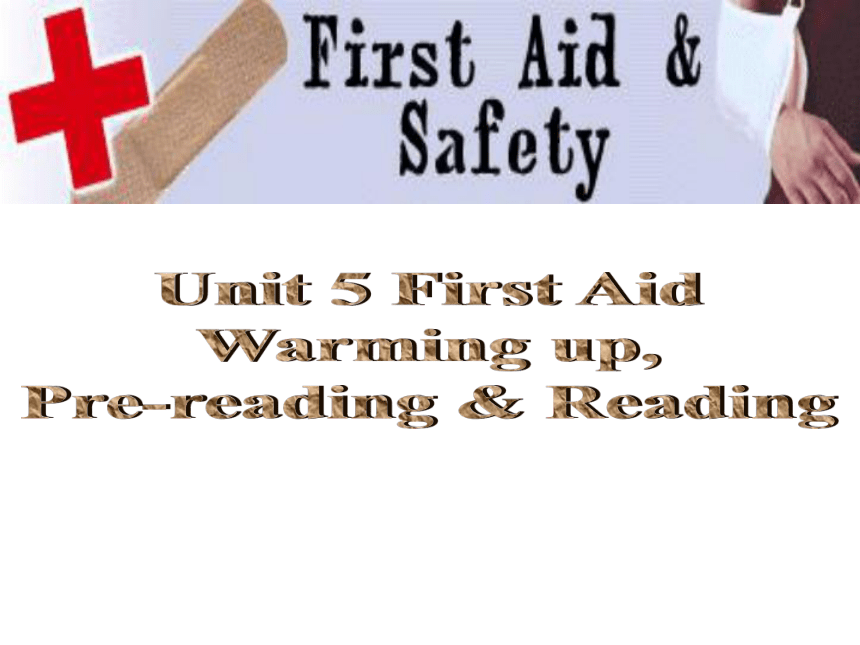 | |
| 格式 | rar | ||
| 文件大小 | 2.6MB | ||
| 资源类型 | 教案 | ||
| 版本资源 | 人教版(新课程标准) | ||
| 科目 | 英语 | ||
| 更新时间 | 2007-12-29 15:14:00 | ||
图片预览

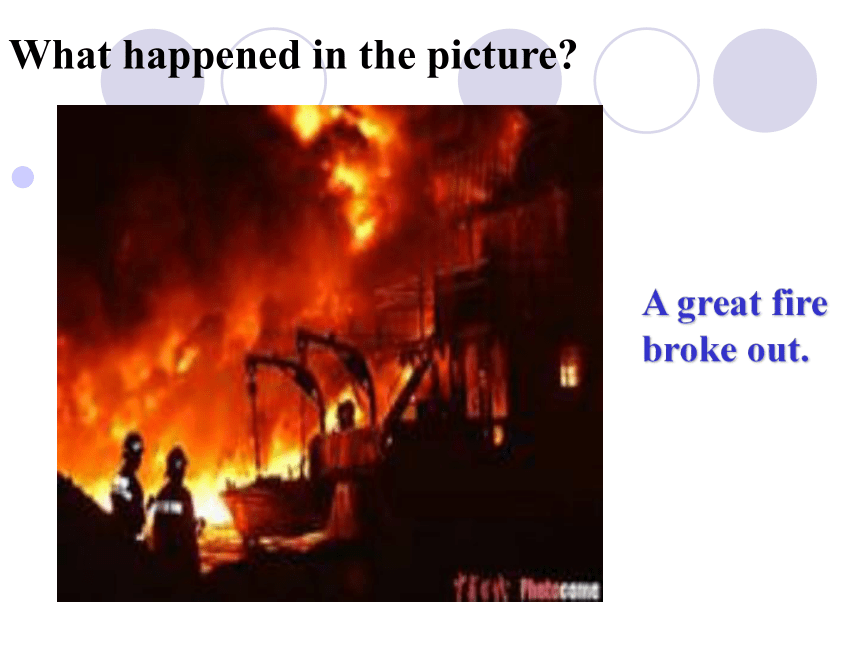
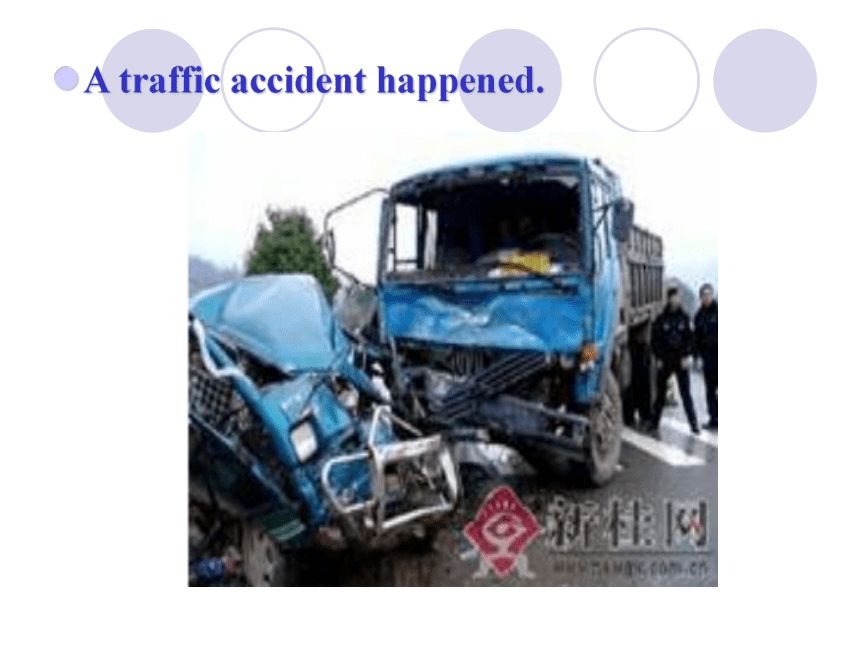
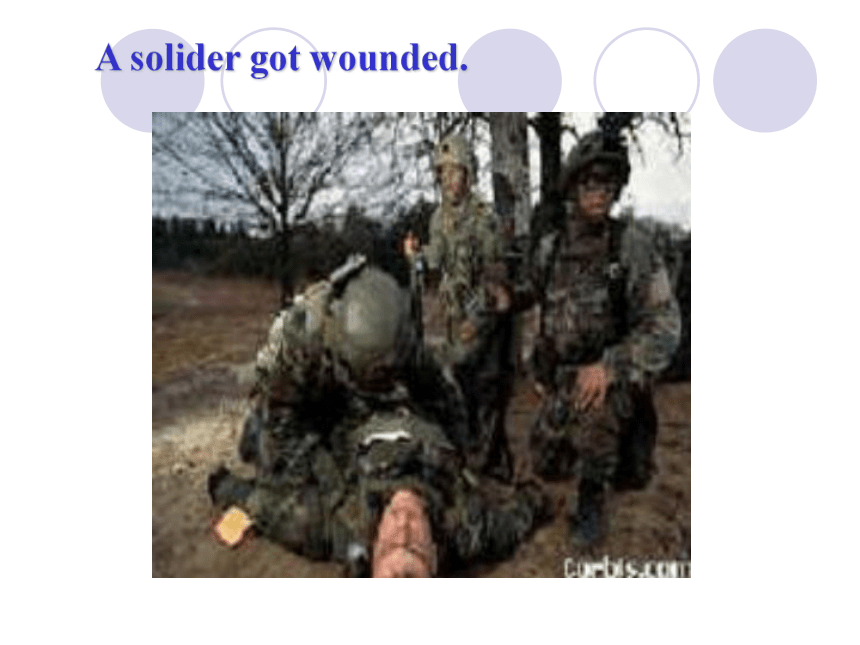
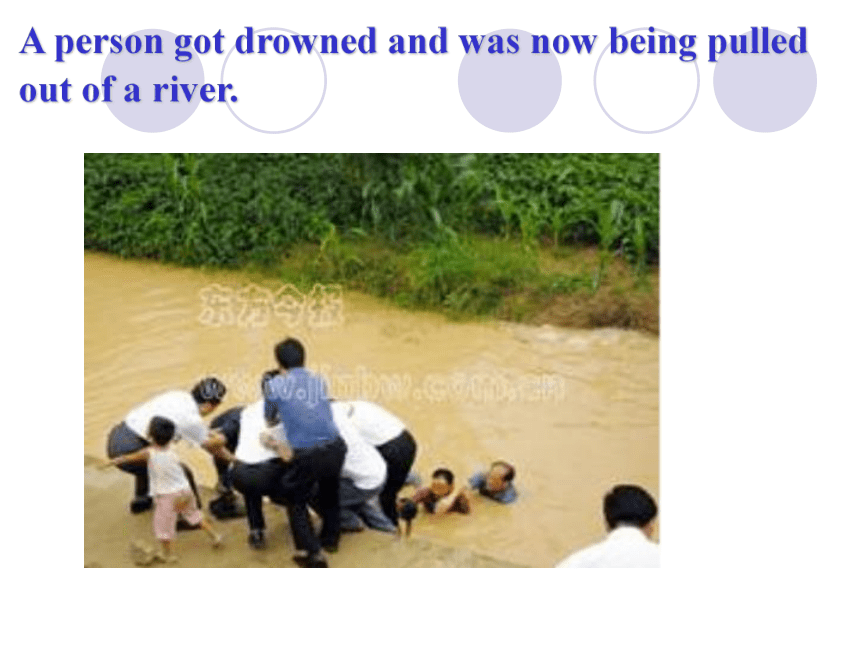
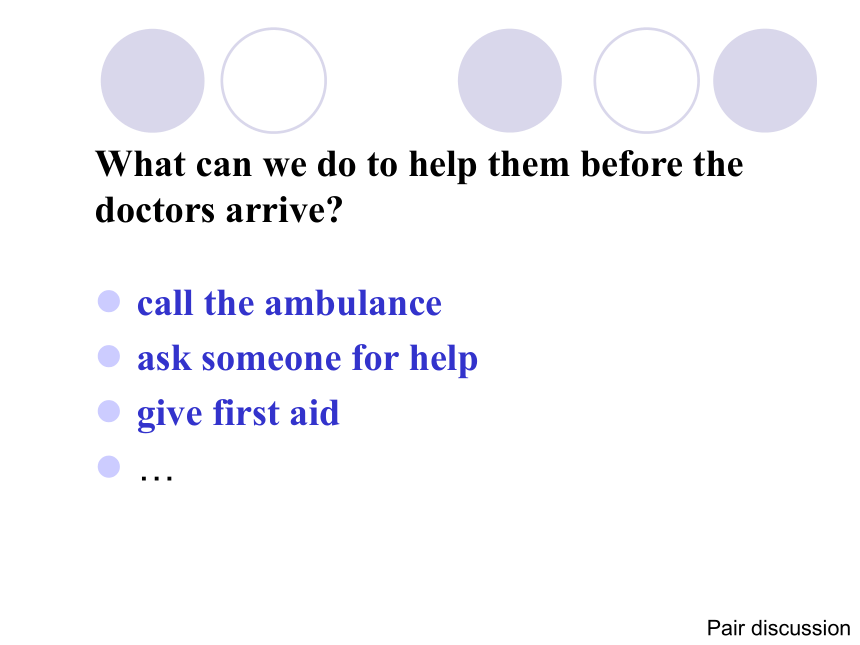
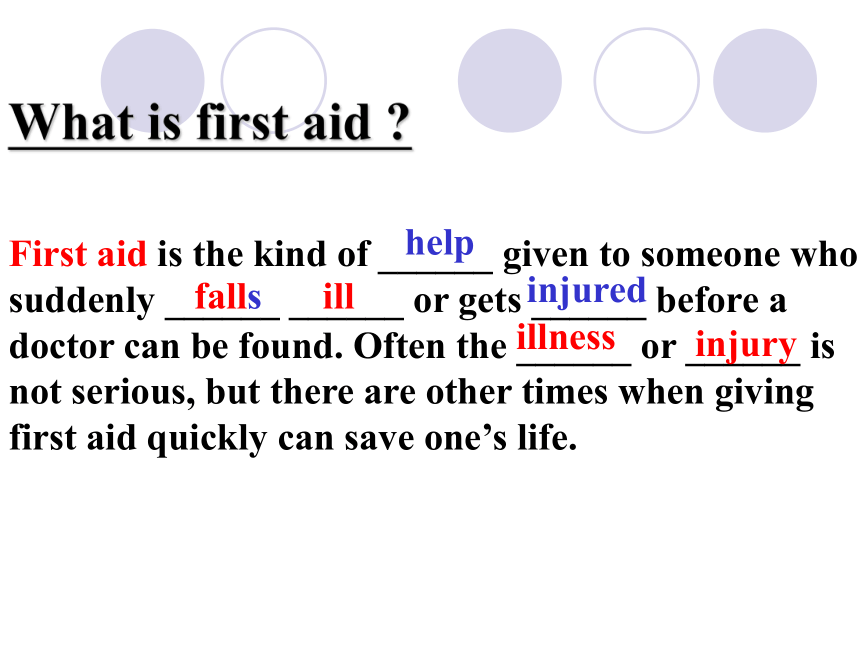
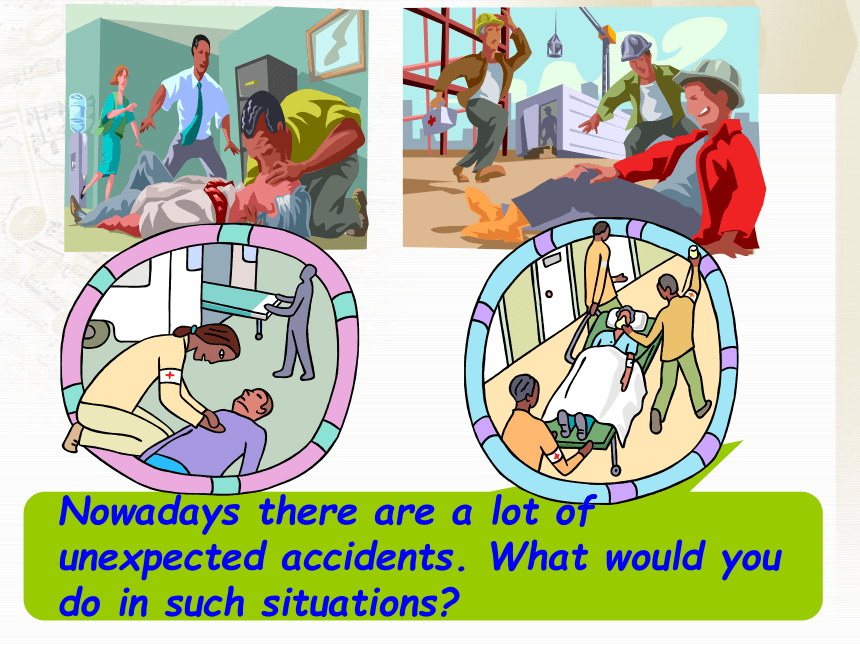
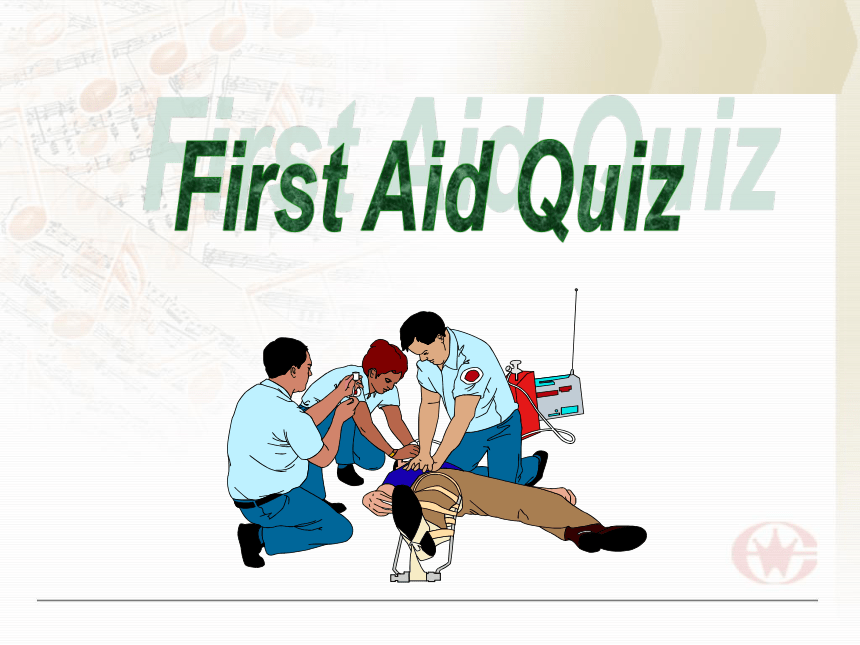
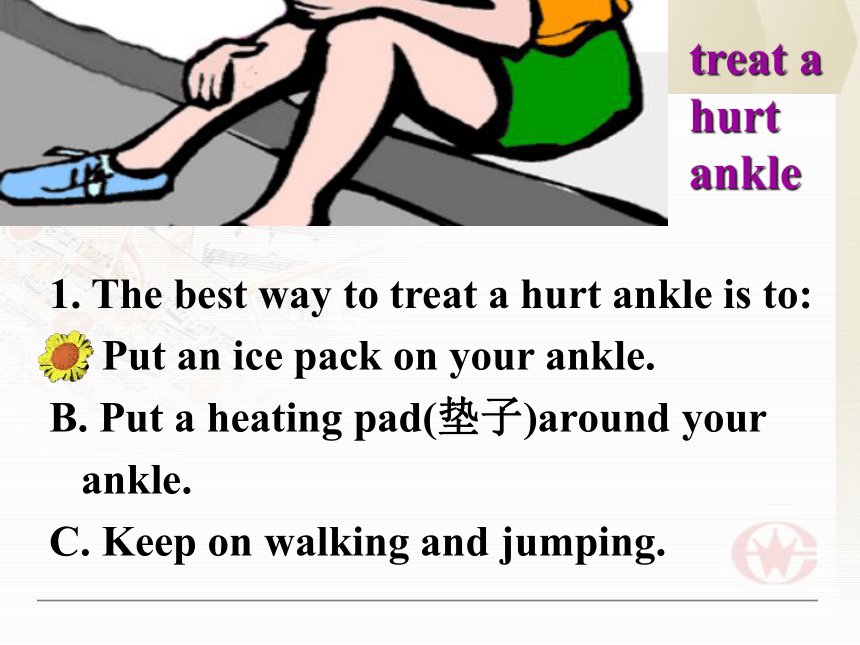
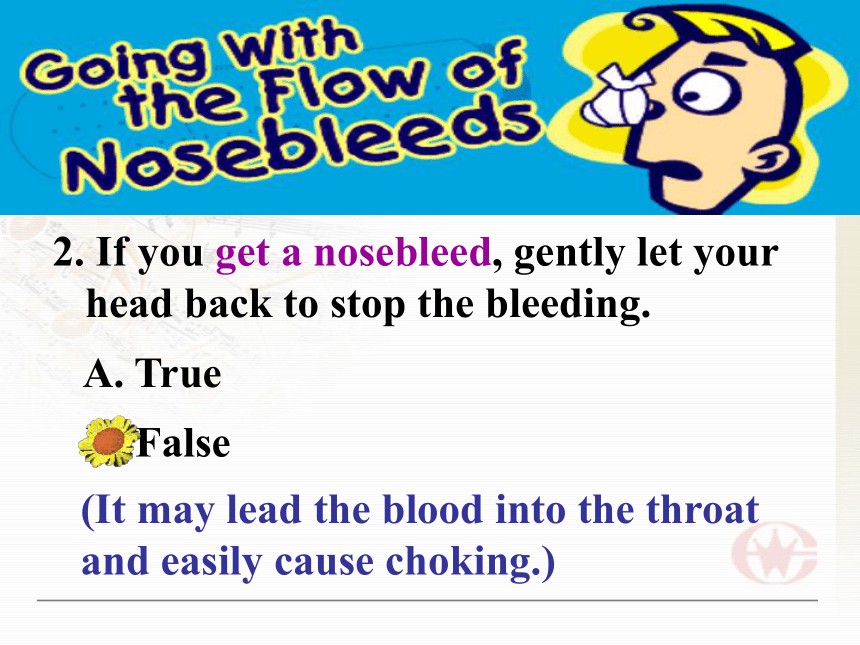
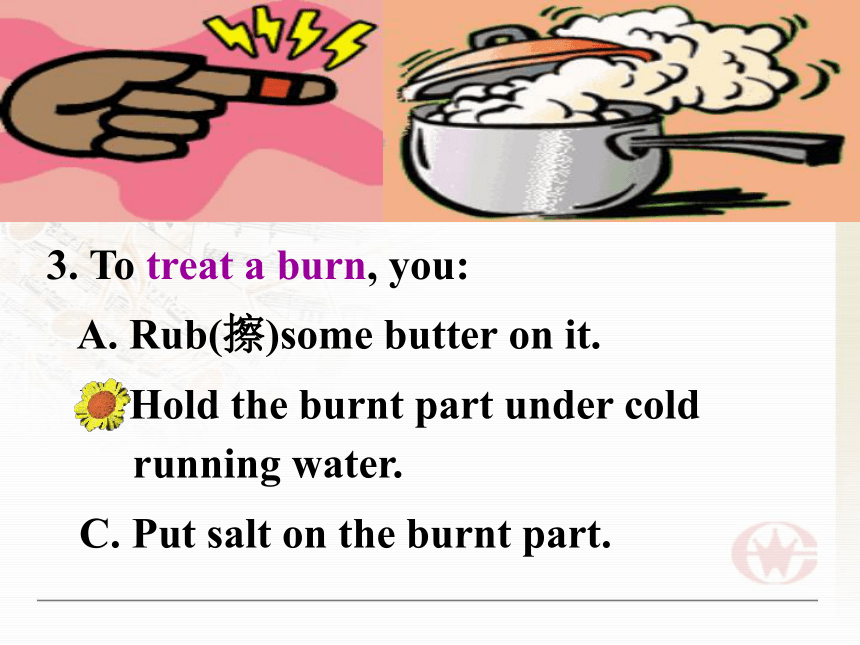
文档简介
课件96张PPT。Unit 5 First Aid
Warming up,
Pre-reading & ReadingWhat happened in the picture? A great fire broke out.A traffic accident happened. A solider got wounded. A person got drowned and was now being pulled out of a river. What can we do to help them before the doctors arrive? call the ambulance
ask someone for help
give first aid
…Pair discussionFirst aid is the kind of ______ given to someone who suddenly ______ ______ or gets ______ before a doctor can be found. Often the ______ or ______ is not serious, but there are other times when giving first aid quickly can save one’s life. help falls illinjured illness injuryWhat is first aid ?Nowadays there are a lot of unexpected accidents. What would you do in such situations?First Aid Quiz1. The best way to treat a hurt ankle is to:
Put an ice pack on your ankle.
Put a heating pad(垫子)around your ankle.
Keep on walking and jumping.treat a hurt ankle2. If you get a nosebleed, gently let your head back to stop the bleeding.
A. True
B. False(It may lead the blood into the throat and easily cause choking.)3. To treat a burn, you:
A. Rub(擦)some butter on it.
B. Hold the burnt part under cold
running water.
C. Put salt on the burnt part. 4. You should wait at least five minutes before touching somebody who has been struck by lightening, or you might get a shock (打击).
A. True
B. False5. Your friend has an asthma(哮喘) attack, but she doesn’t have her medicine. You’d better:
A. Get a paper bag for her to breathe into.
B. Get her a cup of coffee.
C. Take her outside for fresh air. (caffeine咖啡因 can help to dilate扩大 the windpipe气管) 6. To treat a choke, you should make him /her spit by patting him/her on the back.
A. True
B. False7. If someone is having a heart attack, you should first:
A. Call 120
B. Perform CPR (心肺复苏)What has happened in each picture? What kind of first aid should be given?Speaking (Pair work)Listening p.39 bend forward = lean forward 朝前倾斜
the bridge (鼻梁)
swallow 吞下,咽下
wrap up 包起来,围起来
slaps 拍
the shoulder blades (肩胛)
cough out 咳出来
Swelling n.肿胀 a snake bite bleeding a sprained ankle burning clothes choking a broken arm a bloody nose bruising Find out what topics the teacher asks.Listening P39Match each picture with a topic listed in question 1 above. sprained ankle burning clothes nose bleedschokingA bloody nose: Sit down and ________ slightly. Squeeze his nose just below the ______ until the _________ stops.
Burning clothes: Stop him from ______________ as that makes clothes burn faster. Tell him to _____ to the ground and then _____ him up tightly in some heavy cloth. ______ him along the ground until the fire goes out. Listen and fill in the blanks. bend forward bridge bleeding running around drop wrap Roll Choking: Bend him forwards and give him _____quick, hard _____ between the shoulder blades with my hand.
A sprained ankle: Get him to sit down and then put ________ on his ankle to reduce the _________. Get him to put his foot up on a chair. Then I’d _________ his ankle up firmly. fourslaps some ice swelling bandage A snake has bitten him on the leg.Lay the person down and keep him still.
Do not wash the venom(毒液) off the skin.
Apply pressure to the bitten part with your
hands. Do not move him until the doctor comes.a snake biteShe has cut her arm with some broken glass and is bleeding badly.bleedingPut a bandage on the wound and
apply pressure to reduce the bleeding She has broken her arm.a broken armDo not move the broken bone if possible.
Keep the arm still using a bandage.
Call for help immediately.The child has pulled boiling water
onto herself.burn What first aid? What type of burn? Reading First aid for burns Reading skills: Survey the text before reading:title - topic of the articlesubtitles - main idea of each paragraphheadings within subtitles - key words for details main idea of the article first aid for burns causes types characteristics first aid treatment first degree burns second degree burns third degree burns first degree burns second degree burns third degree burnsReadingReadingThe text are divided into five parts.
In which order are these topics
covered? Number them from 1 to 5.____ the three types of burns
____ what to do if someone gets burned
____ the purpose of skin
____ the characteristics of burns
____ how we get burns35142ReadingScan the text for details:1. What can skin do for our body? (P1)● protect you against diseases, poisons
and the sun’s harmful rays
● keep you warm or cool
● prevent you from losing water
● give you sense of touchDetailed reading2. How can we get burnt? (P2)ReadingYou can get burnt by :
____________________________
____________________________
____________________________
____________________________
_______________________________
_______________________________hot liquids,
steam,
fire,
radiation,
the sun,
electricity and chemicals Causes of burns3. How many types of burns? (P3)4. What are the characteristics of
different burns? (P4) red
light swollen red, swollen
blisters
tissue can be seen
swollenReadingThe reading for discussion (P4 & P5):Why should you put cold
water on a burn?2. Why doesn’t a third degree burn hurt?3. Why do you think clothes
and jewellery near burns
should be removed?4. If someone has a third degree burn,
why might you see tissue?Reading1. Why should you put cold water on a burn?
2. Why doesn’t a third degree burn hurt?
3. Why do you think clothes and jewellery near burns should be removed?
4. If someone has a third degree burn, why might you see tissue? The cold water stops the burning process, stops the pain and prevents or reduces swelling. Because nerves have been damaged.Because this may break any blisters and the wound may get infected.These affect all three layers of the skin and any tissue and organs under fires What type of burn
does the little girl
receive? find out what treatment should be given to the little girl.① place cool, clean, wet cloths on the burn② keep cloths cool by putting them back in the
cold water, squeezing them out and placing
them on the burn over and over again.③ Get the girl to the doctor or hospital.Discuss the following situations: Sam knocked over a kettle full of boiling water onto his legs. His legs became red, swollen and covered with blisters. Sam broke the blisters and poured icy water from the fridge onto the skin.2. While ironing clothes, Miss Good accidentally touched the iron. Her wrist blistered and became watery. It hurt a lot. She put her wrist under the cold water tap and then kept placing cool, clean, damp cloths on it until it was less painful. Then she went to see the doctor.wR3. Mrs. Casey’s sleeve caught fire while she was cooking. Her arm looked terrible but it didn’t hurt. The skin was charred. Her husband took off her blouse and picked off bits of the blouse stuck to the burn. He then placed butter on the burn and covered it with a wet bandage.4. After an hour in the sun, Lily noticed her arms were red and hurt a bit. She went home and put them under running water.wRWhat things at home can be dangerous?electrical equipmentelectric wirespoisonsHow to deal with these injuries?kniveshot waterglassgaspets拓展 Making a first-aid kitA well-stocked(存备得好的) first-aid kit, kept in easy reach, is necessary in every home. It should include: bandage soap sharp scissorsthermometer plastic gloves (at least 2 pairs)flashlightalcoholyour list of emergency phone numbers…emergency medical service
fire department police department
parent(s) at work, including cell phone
neighbor or relative120119110Language pointsaid 帮助,援助,赞助
first aid 急救
come/ go to sb’s aid 援助某人
with the aid of 在… 的帮助下
aid sb with sth 帮助某人做某事
aid sb in doing sth 帮助某人做某事
E.g. ① He came to my aid at once.
② He was able to find the museum with the aid
of a map.
③ We aided him in raising the money.2. fall ill 生病 属短暂性动词, 不与
for + 时间段连用
be ill 指生病的状态,是持续性行为, 可与
for + 时间段连用His wife suddenly fell ill last week.
He has been ill for a week.fall 用作系动词,后常接形容词.
fall asleep 睡着
fall silent 沉默不语3 save one’s life 救某人的命 save one’s honor save one’s face save one’s skin 保全名誉保全面子避免受伤4 Did you or someone else give help in any of them? If so, …
If so, = If it is true,Do you want to be a superman? If so, come with me!
If so, =If you want,5 bite (bit, bitten)bite off more than one can chew贪多嚼不烂
Once bitten, twice shy. 吃一堑,长一智。
bite the hand that feeds one 恩将仇报
bite a person’s head off 严厉斥责,口气凶猛
6 protect … against from doing sth 保护、维护
prevent … from doing sth 防止、妨碍
He put on his coat to protect himself from catching
cold.Nothing will prevent us from reaching our aim. 7 …and it gives you your sense of touch.sense of touch 触觉 sense of sight 视觉
sense of hearing 听觉 sense of taste 味觉
sense of smell嗅觉 sense of humor幽默感
sense of urgency紧迫感 sense of beauty 美感 8. treatment 不可数名词 “ 对待, 待遇,处理; 治疗”工人们受到政府优厚的待遇.The workers received good treatment from the
Government.可数名词 . “ 疗法”他们正在实验一种治疗癌症的新疗法.
They are trying _____________________________a new treatment for cancerbe under treatment 在治疗中
be under one’s treatment 接受某人的治疗
for treatment 进行治疗
treatment for + 疾病的名词 治…病的方法9 depend on
①取决于;
The price depends on the quality.②依赖、依靠;
e.g 他的一家人全靠他养活。
His family depends on him.③信赖、信任;
e.g 我相信你们可以在星期五前完成你们的作业。
I depend on you to finish your homework by Friday.10 heal vt. & vi.
(尤指伤口)治愈; 恢复健康 heal a wound
使和解
healer (cn) 医治者;治疗物
Time is a great healer. 时间能够治好创伤。辨析:treat, heal, cure
treat “治疗”,着重强调过程,不涉及结果,不一定治愈。
heal 多用于治疗外伤。
cure “治愈”,强调结果。 11. swell v. 膨胀,隆起 ①她的腿肿得很厉害。
②风鼓起了帆。
③大雨使河水上涨了。 Her leg has swollen badly. The wind swelled the sails. The heavy rain swelled the river. swollen 可作形容词,表示“ 肿胀的” Her eyes were red and swollen with weeping.
她的眼睛哭得又红又肿。Swelling n.肿胀The bee sting has left a swelling on my hand.
我手上蜜蜂叮咬处留下了一个肿块。12 damage v. 损害, 损坏
n. 损害, 毁坏, 破坏 ( 不可数) ①这场战争损害了两国之间的关系。
②地震造成了重大破坏。 The war damaged the relations between the
countries. The earthquake caused great damage.13 jewellery 和jewel 的辨析:
两者均有“ 珍宝首饰” 之意,jewellery 为集体
名词, 不可数;jewel 为可数名词① She appeared at the party wearing some of
her finest________.
jewels B. jewelleries C. jewel D. jewellers
② I want to buy ____ as a birthday gift for my
daughter.
some jewel B. a piece of jewel
C. a jewellery D. a piece of jewelleryAD14 squeeze out 榨出, 挤出他们被年轻人挤出了就业市场。They have been squeezed out of the job
market by young people.squeeze money from sb 向某人勒索钱财
squeeze money out of sb 那个年轻人经常向那个小学生勒索钱财。The young man often squeezes money from/
out of the pupil.15. wound n.伤,创伤 v. 伤害,使受伤区别wound, injure, harm 与 hurt:
wound 指外伤,如枪伤,刀伤等, 尤指
在战场上受伤;也可指在感情上荣誉方面的创伤。
injure 指意外或事故造成损伤,强调功能的损失。
harm 指损害有生命或无生命的东西;也可指
肉体上或精神上的损害。
hurt (普通用语)指任何肉体或精神上的伤害。
尤指打伤,刺伤;还可表示“疼痛”。The bullet wounded him in his arm.
子弹打伤了他的手臂。
He was injured in a traffic accident.
他在一次交通事故中受了伤。
We won’t do anything that will harm the cause
of peace.
我们不会做任何危及和平事业的事。
He fell off the ladder and hurt his leg.
他从梯子上摔下来,伤了腿。
The hurt to his feelings is more serious than
the hurt in his body.16. sit up ① (使或帮助)坐起来;坐起来吃药吧。 Sit up and take your medicine.② 端坐,坐正,坐直;③ 熬夜。=stay up
I sat up late reading a novel.Heroic Teenager Receives Awardadj.n. hero/heroine1.Who is the heroic teenager ?
2.What is the award?
3. Why does he receive the award?
Careful reading
1. Who was Anne? What happened to her ?
2. What first aid did John perform on Anne?
3. How did John get knowledge of first aid? Who was Anne?
What happened to her ?Anne Slade, mother of three, had been
stabbed repeatedly with a knife. She
was lying in her front garden bleeding very
heavily. Her hands had almost been cut off.2. What first aid did John perform
on Anne?John dressed Ms Slide’s injuries with
tea towels and tapes and applied pressure
to the wounds to slow the bleeding.Why did he use tea towels ? Nobody could put their hands on any bandage. How did John get knowledge of first aid?John had taken part in the Young Lifesaver
Scheme at his high school.The scheme was very important .It was John’s quick action and knowledge
of first aid that saved Ms Slade’s life.It shows that a knowledge of first aid can
make a real difference.What adjectives can you find to describe
John’s action?quick-thinkinghelpfulfearlessconfidentcourageousheroicunselfish4 2 6 1 7 3 5 81. The attacker ran away.
2. Anne was attacked and started to scream.
3. John performed first aid on Anne.
4. John was studying in his house.
5. The ambulance arrived.
6. John ran outside with his father.
7. John found Anne in her garden with terrible knife wounds.
8. John was presented with his award at ceremony
which recognized the bravery of ten people. Put these events in the correct order.
1. John was presented with his award at a ceremony which recognised the bravery of ten people who had saved the life of another.Difficult sentencesbe presented with sth:be given withwhich 引导一个定语从句who引导一个定语从句Present
(1) 给予,赠送用法结构:present + sb. + with + sth. 授予某人……
He presented her with a gold medal.
present + sth. + to + sb. 颁发……给某人
He presented a gold medal to her.(2) 提出,呈现
present reasons 提出理由
上演
present a new play2. It was John’s quick action and knowledge of first aid that saved Ms Slade’s life.It is … that… 强调句It was his words that hurt her.4. put one’s hands on
I know their address is here
somewhere, but I can’t put my hands
on it (找到它) right now.
Whatever he puts his hands on (他无论
着手做什么), he does it extraordinarily
well.5. John used these to dress the most severe injuries to Ms Slade’s hand.dress 敷裹,包扎Tom had to return to the camp to dress his injuries.Immediately after his wound was dressed, he went to work. There is some doubt whether John will come.约翰是否会来还很难说。There is no doubt that John will come.毫无疑问, 约翰一定会来。5. There is no doubt that John’s quick thinking and the first aid skills he learned at school…高考“省略句”面面观Ellipsis英语中有时为了避免重复,使语言简练紧凑,在不损害句子结构或不引起误解的原则下,往往省去一个或多个句子成分或词语。现把高考中的省略句式归纳如下:一、状语从句中句子成分的省略在以when, while, if, as if, though (although), as, whether, once等连词引导的时间、原因、条件、方式、让步等状语从句中,常常省略相同的主语或作主语的代词it以及be动词,保留现在分词、过去分词、介词短语、不定式等。 e.g. 1. Generally speaking, ________according to directions, the drug has no side effect.
A. when taking B. when taken
C. when to take D. when to be takenB2. Though ________ money, his parents managed to send him to university.
A. lacked B. lacking of
C. lacking D. lacked in 3. When ________, the museum will be open to the public next year.
A. completed B. completing
C. being completed D. to be completed4. The research is so designed that once ______ nothing can be done to change it.
A. begins B. having begun
C. beginning D. begun CAD5. If ________ the same treatment again, he's sure to get well.
A. Giving B. give C. given D. being given 6. While building a tunnel through the mountain, ________.
A. an underground lake was discovered
B. there was an underground lake discovered
C. a lake was discovered underground
D. the workers discovered an underground lake二、动词不定式的省略在同一句或联系紧密的对话里,常把不定式to后内容相同的部分省略,只保留to。 CD1. --- You should have thanked her before you left.
--- I meant ________, but when I was leaving I couldn't find her anywhere.
A. to do B. to
C. doing D. doing it2. The boy wanted to ride his bicycle in the street, but his mother told him ________.
A. not to B. not to do C. not do it D. do not to 3. --- I'll be away on a business trip. Would you mind looking after my cat?
---Not at all. ________.
A. I've no time B. I'd rather not
C. I'd like it D. I'd be happy to BAD三、虚拟条件句中连词if的省略 在虚拟条件句中,如含有had, were, should等时,if可省略,句子倒装。 What would have happened ________, as far as the river bank?
A. Bob had walked farther
B. if Bob should walk farther
C. had Bob walked farther
D. if Bob walked farther 四、宾语从句的省略在同一句或联系紧密的对话里,后一句常常省略内容相同的宾语从句或从句的一部分。 e.g. Had I known that air conditioners cause so much pollution, I would have never bought one.C--- Do you think it's going to rain over the weekend?
--- ________.
A. I don't believe B. I don't believe it
C. I believe not so D. I believe not 五、主、谓、宾等成分的省略在英语情景会话中,答语常常省略不会引起歧义的主语、谓语或宾语部分,而只保留对方希望了解的内容。在复合句或并列句中,也有省略主、谓、宾的情况。 1. ---What do you think made Mary so upset?
---________her new bicycle.
A. As she lost B. Lost
C. Losing D. Because of losingDC2. One of the sides of the board should be painted yellow, and________.
A. the other is white B. another white
C. the other white D. another is white3. --- Would you like some wine?
--- Yes, just ________.
A. little B. very little C. a little D. a fewCCBest wishes to you!简单句中的省略1、省略主语 祈使句中主语通常省略;其它省略主语多限于少数现成的说法。(1) (I) Thank you for your help.
(2) (I) See you tomorrow.
(3) (It) Doesn’t matter.
(4) (I) Beg your pardon.简单句中的省略2、省略主谓或主谓语的一部分 (1) (There is) No smoking .
(2) (Is there) Anything wrong ?
(3) (Will you) Have a smoke ?
(4) What/How (do you think) about a cup of tea ?
(5) Why (do you) not say hello to him ?简单句中的省略3、省略作宾语的不定式短语,只保留to,但如果该宾语是动词be或完成时态,则须在之后加上be或have:(1) –Are you going there? --Yes, I’d like to (go there).
(2) He didn’t give me the chance, though he had promised to (give me the chance).
(3) –Are you an engineer? --No, but I want to be.
(4) –He hasn’t finished the task yet. --Well, he ought to have.简单句中的省略4、省略表语 (1) –Are you thirsty? --Yes, I am (thirsty).
(2) His brother isn’t lazy, nor is his sister (lazy).5、同时省略几个成分 (1) Let’s meet at the same place as (we met) yesterday.
(2) –-Have you finished your work ?
---(I have) Not (finished my work) yet.主从复合句中的省略1.省略主语和谓语的现象在交际用语中经常出现。 (1) ( I’m ) Sorry to hear you are ill.
(2) ( It’s a ) Pity that he missed such a good chance.2.一部分表示心理愿望和猜测的动词后面,可用或必须用so或not,来表示对某一说法的肯定或否定态度。(1) –Is he coming back tonight? --I think so.
(2) –She must be busy now? --If so, she can’t go with us.
(3) –Is she feeling better today? --I’m afraid not.
(4) –Do you think he will attend the meeting? --I guess not.
这种用法常见的有:How so? Why so? Is that so? I hope so. He said so.及I suppose/believe/hope not. 并列句中的省略 两个并列句中,后一个分句常省略与前一分句中相同的部分。 (1) My father is a doctor and my mother (is) a nurse.
(2) I study at college and my sister (studies) at high school.
(3) When summer comes, the day is getting longer and longer, and the night (is getting) shorter and shorter.其他省略1、连词的that省略宾语从句中常省略连词that,但也有不能省略的情况。
(2) 在定语从句中,that在从句中作宾语时可省略.另外,凡是进行时态和被动语态的定语从句都可省略关系代词和be 动词。(变成分词做定语修饰先行词)2、在某些状语从句中,从句的主语与主句的主语一致时,可省去“主语+be”部分 When (he was) still a boy of 10, he had to work day and night.
She tried her best though (she was) rather poor in health.
If (you are) asked you may come in.
If (it is) necessary I’ll explain to you again.其他省略3、不定式符号to的省略并列的不定式可省去后面的 to.
I told him to sit down and wait for a moment.
(2) help 当“帮助”讲时,后面的宾语或宾补的不定式符号to可带可不带.
I will help (to) do it for you. I will help you (to) do it.
(3)介词but前若有动词do,后面的不定式不带 to.
The boy did nothing but play.
but是介词,其后常跟不定式做宾语.不定式是否带to的判定方法是;but之前有个行为动词do, but之后不带to do...but do/ have...but to do 其他省略(4) 某些使役动词(let, make, have)及感官动词(see, watch, hear, notice, observe, feel, look at, listen to等)后面作宾语补足语的不定式一定要省去 to, 但在被动语态中须将to 复原。
I saw the boy fall from the tree.
The boy was seen to fall from the tree.
The boss made us work 12 hours a day.
We were made to work 12 hours a day.简单句中的省略3、省略作宾语的不定式短语,只保留to,但如果该宾语是动词be或完成时态,则须在之后加上be或have:(1) –Are you going there? --Yes, I’d like to (go there).
(2) He didn’t give me the chance, though he had promised to (give me the chance).
(3) –Are you an engineer? --No, but I want to be.
(4) –He hasn’t finished the task yet. --Well, he ought to have.其他省略(5) 主语从句中有动词do,后面作表语的不定式的 to可带可不带。
All we can do now is (to) wait.
(6) find 当“发现”讲时,后面作宾语补足语的不定式符号to可带可不带。
We found him (to) work very hard at the experiment.
但如果是不定式 to be,则不能省略。
She found him to be dishonest. 其他省略4、连词if在部分虚拟条件句中可省略,但后面的语序有变化。 Had they time, they would certainly come and help us.
(2) Were I you, I would do the work better.
(3)Should there be a flood, what should we do?5、主句和从句各有一些成分省略。The sooner (you do it), the better (it will be).
When first _____ to the market,
these products enjoyed great success.
A. introducing B. introduced
C. introduce D. being introduced
分析:when引导的时间状语从句,如果从句的主语和主句的
主语相同,且从句中谓语部分有be时,可以省略句中的主语和be,
本句中when后面省略了these products were.
2. It shames me to say it, but I told a lie
when _____ at the meeting by my boss.
A. questioning B. having questioned
C. questioned D. to be questioned
分析:本句when后面省略了I was
3. —Susan, will you please go and empty that drawer?
??—______?
What for B. What is it
C. How is it D. How come分析:第二个人不知道为什么要倒空抽屉,所以问
为什么。What for(为什么)它的完整表达应是
What are you going to use the empty drawer for ?
4. I’m looking forward as much to her return
as she herself to _____ me.
have seen B. seeing
C. meet D. be met分析:本句后半部分as she herself to _____me是as
she herself is looking forward to seeing me的省略。
6. Who can you turn to in time of danger,
if not ______?
Ourselves B. ours
C. we D. us分析: if not ______ 是if you don’t turn to
us 的省略。
7. —Did you visit the museum last week ?
?—No, we _____, but we spent too much
time shopping.
could have B. could
C. must have D. must分析:句中we _____是we could have
visited the museum last week.的省略形式。
8. —Is your mother going to the supermarket ?
?—No, ______.
A. she doesn’t B. she’s cooking
C. she gets by bus D. to a tailor’s shop分析:根据对话的语境,表明:我妈妈不打算
去超市,而是去裁缝铺。to a tailor’s shop
是She is going to a tailor’s shop.的省略。 9. —She may not be free today.
??—_____, we’ll have to put the meeting off.
If may
B. If not
C. If she may not
D. If she may not be free today
分析:答语的前半部分的完整回答应是:
If she is not free today. 1. He was squeezed out of the job market by the young people.
2. I’ve warned you over and over again not to do such silly things.
3. Hold the bandage in place with tape.
4. The storm didn’t do much damage to the crops.
5. I don’t doubt that he can finish the task on time.
6.Stick to a task until it is finished.
7.Laws must be carried out seriously once made.
8. It was the nurse’s quick action and knowledge of first aid that saved the boy.1. The injured in the traffic accident were taken to the hospital as soon as possible.
2. We are in great need of some bandages, could you put your hands on some?
3. Our water supply has been cut off for a month because of draught.
4. He recognized his lack of knowledge and decided to learn from the beginning.
5. They applied these ruled to beginners only.
Warming up,
Pre-reading & ReadingWhat happened in the picture? A great fire broke out.A traffic accident happened. A solider got wounded. A person got drowned and was now being pulled out of a river. What can we do to help them before the doctors arrive? call the ambulance
ask someone for help
give first aid
…Pair discussionFirst aid is the kind of ______ given to someone who suddenly ______ ______ or gets ______ before a doctor can be found. Often the ______ or ______ is not serious, but there are other times when giving first aid quickly can save one’s life. help falls illinjured illness injuryWhat is first aid ?Nowadays there are a lot of unexpected accidents. What would you do in such situations?First Aid Quiz1. The best way to treat a hurt ankle is to:
Put an ice pack on your ankle.
Put a heating pad(垫子)around your ankle.
Keep on walking and jumping.treat a hurt ankle2. If you get a nosebleed, gently let your head back to stop the bleeding.
A. True
B. False(It may lead the blood into the throat and easily cause choking.)3. To treat a burn, you:
A. Rub(擦)some butter on it.
B. Hold the burnt part under cold
running water.
C. Put salt on the burnt part. 4. You should wait at least five minutes before touching somebody who has been struck by lightening, or you might get a shock (打击).
A. True
B. False5. Your friend has an asthma(哮喘) attack, but she doesn’t have her medicine. You’d better:
A. Get a paper bag for her to breathe into.
B. Get her a cup of coffee.
C. Take her outside for fresh air. (caffeine咖啡因 can help to dilate扩大 the windpipe气管) 6. To treat a choke, you should make him /her spit by patting him/her on the back.
A. True
B. False7. If someone is having a heart attack, you should first:
A. Call 120
B. Perform CPR (心肺复苏)What has happened in each picture? What kind of first aid should be given?Speaking (Pair work)Listening p.39 bend forward = lean forward 朝前倾斜
the bridge (鼻梁)
swallow 吞下,咽下
wrap up 包起来,围起来
slaps 拍
the shoulder blades (肩胛)
cough out 咳出来
Swelling n.肿胀 a snake bite bleeding a sprained ankle burning clothes choking a broken arm a bloody nose bruising Find out what topics the teacher asks.Listening P39Match each picture with a topic listed in question 1 above. sprained ankle burning clothes nose bleedschokingA bloody nose: Sit down and ________ slightly. Squeeze his nose just below the ______ until the _________ stops.
Burning clothes: Stop him from ______________ as that makes clothes burn faster. Tell him to _____ to the ground and then _____ him up tightly in some heavy cloth. ______ him along the ground until the fire goes out. Listen and fill in the blanks. bend forward bridge bleeding running around drop wrap Roll Choking: Bend him forwards and give him _____quick, hard _____ between the shoulder blades with my hand.
A sprained ankle: Get him to sit down and then put ________ on his ankle to reduce the _________. Get him to put his foot up on a chair. Then I’d _________ his ankle up firmly. fourslaps some ice swelling bandage A snake has bitten him on the leg.Lay the person down and keep him still.
Do not wash the venom(毒液) off the skin.
Apply pressure to the bitten part with your
hands. Do not move him until the doctor comes.a snake biteShe has cut her arm with some broken glass and is bleeding badly.bleedingPut a bandage on the wound and
apply pressure to reduce the bleeding She has broken her arm.a broken armDo not move the broken bone if possible.
Keep the arm still using a bandage.
Call for help immediately.The child has pulled boiling water
onto herself.burn What first aid? What type of burn? Reading First aid for burns Reading skills: Survey the text before reading:title - topic of the articlesubtitles - main idea of each paragraphheadings within subtitles - key words for details main idea of the article first aid for burns causes types characteristics first aid treatment first degree burns second degree burns third degree burns first degree burns second degree burns third degree burnsReadingReadingThe text are divided into five parts.
In which order are these topics
covered? Number them from 1 to 5.____ the three types of burns
____ what to do if someone gets burned
____ the purpose of skin
____ the characteristics of burns
____ how we get burns35142ReadingScan the text for details:1. What can skin do for our body? (P1)● protect you against diseases, poisons
and the sun’s harmful rays
● keep you warm or cool
● prevent you from losing water
● give you sense of touchDetailed reading2. How can we get burnt? (P2)ReadingYou can get burnt by :
____________________________
____________________________
____________________________
____________________________
_______________________________
_______________________________hot liquids,
steam,
fire,
radiation,
the sun,
electricity and chemicals Causes of burns3. How many types of burns? (P3)4. What are the characteristics of
different burns? (P4) red
light swollen red, swollen
blisters
tissue can be seen
swollenReadingThe reading for discussion (P4 & P5):Why should you put cold
water on a burn?2. Why doesn’t a third degree burn hurt?3. Why do you think clothes
and jewellery near burns
should be removed?4. If someone has a third degree burn,
why might you see tissue?Reading1. Why should you put cold water on a burn?
2. Why doesn’t a third degree burn hurt?
3. Why do you think clothes and jewellery near burns should be removed?
4. If someone has a third degree burn, why might you see tissue? The cold water stops the burning process, stops the pain and prevents or reduces swelling. Because nerves have been damaged.Because this may break any blisters and the wound may get infected.These affect all three layers of the skin and any tissue and organs under fires What type of burn
does the little girl
receive? find out what treatment should be given to the little girl.① place cool, clean, wet cloths on the burn② keep cloths cool by putting them back in the
cold water, squeezing them out and placing
them on the burn over and over again.③ Get the girl to the doctor or hospital.Discuss the following situations: Sam knocked over a kettle full of boiling water onto his legs. His legs became red, swollen and covered with blisters. Sam broke the blisters and poured icy water from the fridge onto the skin.2. While ironing clothes, Miss Good accidentally touched the iron. Her wrist blistered and became watery. It hurt a lot. She put her wrist under the cold water tap and then kept placing cool, clean, damp cloths on it until it was less painful. Then she went to see the doctor.wR3. Mrs. Casey’s sleeve caught fire while she was cooking. Her arm looked terrible but it didn’t hurt. The skin was charred. Her husband took off her blouse and picked off bits of the blouse stuck to the burn. He then placed butter on the burn and covered it with a wet bandage.4. After an hour in the sun, Lily noticed her arms were red and hurt a bit. She went home and put them under running water.wRWhat things at home can be dangerous?electrical equipmentelectric wirespoisonsHow to deal with these injuries?kniveshot waterglassgaspets拓展 Making a first-aid kitA well-stocked(存备得好的) first-aid kit, kept in easy reach, is necessary in every home. It should include: bandage soap sharp scissorsthermometer plastic gloves (at least 2 pairs)flashlightalcoholyour list of emergency phone numbers…emergency medical service
fire department police department
parent(s) at work, including cell phone
neighbor or relative120119110Language pointsaid 帮助,援助,赞助
first aid 急救
come/ go to sb’s aid 援助某人
with the aid of 在… 的帮助下
aid sb with sth 帮助某人做某事
aid sb in doing sth 帮助某人做某事
E.g. ① He came to my aid at once.
② He was able to find the museum with the aid
of a map.
③ We aided him in raising the money.2. fall ill 生病 属短暂性动词, 不与
for + 时间段连用
be ill 指生病的状态,是持续性行为, 可与
for + 时间段连用His wife suddenly fell ill last week.
He has been ill for a week.fall 用作系动词,后常接形容词.
fall asleep 睡着
fall silent 沉默不语3 save one’s life 救某人的命 save one’s honor save one’s face save one’s skin 保全名誉保全面子避免受伤4 Did you or someone else give help in any of them? If so, …
If so, = If it is true,Do you want to be a superman? If so, come with me!
If so, =If you want,5 bite (bit, bitten)bite off more than one can chew贪多嚼不烂
Once bitten, twice shy. 吃一堑,长一智。
bite the hand that feeds one 恩将仇报
bite a person’s head off 严厉斥责,口气凶猛
6 protect … against from doing sth 保护、维护
prevent … from doing sth 防止、妨碍
He put on his coat to protect himself from catching
cold.Nothing will prevent us from reaching our aim. 7 …and it gives you your sense of touch.sense of touch 触觉 sense of sight 视觉
sense of hearing 听觉 sense of taste 味觉
sense of smell嗅觉 sense of humor幽默感
sense of urgency紧迫感 sense of beauty 美感 8. treatment 不可数名词 “ 对待, 待遇,处理; 治疗”工人们受到政府优厚的待遇.The workers received good treatment from the
Government.可数名词 . “ 疗法”他们正在实验一种治疗癌症的新疗法.
They are trying _____________________________a new treatment for cancerbe under treatment 在治疗中
be under one’s treatment 接受某人的治疗
for treatment 进行治疗
treatment for + 疾病的名词 治…病的方法9 depend on
①取决于;
The price depends on the quality.②依赖、依靠;
e.g 他的一家人全靠他养活。
His family depends on him.③信赖、信任;
e.g 我相信你们可以在星期五前完成你们的作业。
I depend on you to finish your homework by Friday.10 heal vt. & vi.
(尤指伤口)治愈; 恢复健康 heal a wound
使和解
healer (cn) 医治者;治疗物
Time is a great healer. 时间能够治好创伤。辨析:treat, heal, cure
treat “治疗”,着重强调过程,不涉及结果,不一定治愈。
heal 多用于治疗外伤。
cure “治愈”,强调结果。 11. swell v. 膨胀,隆起 ①她的腿肿得很厉害。
②风鼓起了帆。
③大雨使河水上涨了。 Her leg has swollen badly. The wind swelled the sails. The heavy rain swelled the river. swollen 可作形容词,表示“ 肿胀的” Her eyes were red and swollen with weeping.
她的眼睛哭得又红又肿。Swelling n.肿胀The bee sting has left a swelling on my hand.
我手上蜜蜂叮咬处留下了一个肿块。12 damage v. 损害, 损坏
n. 损害, 毁坏, 破坏 ( 不可数) ①这场战争损害了两国之间的关系。
②地震造成了重大破坏。 The war damaged the relations between the
countries. The earthquake caused great damage.13 jewellery 和jewel 的辨析:
两者均有“ 珍宝首饰” 之意,jewellery 为集体
名词, 不可数;jewel 为可数名词① She appeared at the party wearing some of
her finest________.
jewels B. jewelleries C. jewel D. jewellers
② I want to buy ____ as a birthday gift for my
daughter.
some jewel B. a piece of jewel
C. a jewellery D. a piece of jewelleryAD14 squeeze out 榨出, 挤出他们被年轻人挤出了就业市场。They have been squeezed out of the job
market by young people.squeeze money from sb 向某人勒索钱财
squeeze money out of sb 那个年轻人经常向那个小学生勒索钱财。The young man often squeezes money from/
out of the pupil.15. wound n.伤,创伤 v. 伤害,使受伤区别wound, injure, harm 与 hurt:
wound 指外伤,如枪伤,刀伤等, 尤指
在战场上受伤;也可指在感情上荣誉方面的创伤。
injure 指意外或事故造成损伤,强调功能的损失。
harm 指损害有生命或无生命的东西;也可指
肉体上或精神上的损害。
hurt (普通用语)指任何肉体或精神上的伤害。
尤指打伤,刺伤;还可表示“疼痛”。The bullet wounded him in his arm.
子弹打伤了他的手臂。
He was injured in a traffic accident.
他在一次交通事故中受了伤。
We won’t do anything that will harm the cause
of peace.
我们不会做任何危及和平事业的事。
He fell off the ladder and hurt his leg.
他从梯子上摔下来,伤了腿。
The hurt to his feelings is more serious than
the hurt in his body.16. sit up ① (使或帮助)坐起来;坐起来吃药吧。 Sit up and take your medicine.② 端坐,坐正,坐直;③ 熬夜。=stay up
I sat up late reading a novel.Heroic Teenager Receives Awardadj.n. hero/heroine1.Who is the heroic teenager ?
2.What is the award?
3. Why does he receive the award?
Careful reading
1. Who was Anne? What happened to her ?
2. What first aid did John perform on Anne?
3. How did John get knowledge of first aid? Who was Anne?
What happened to her ?Anne Slade, mother of three, had been
stabbed repeatedly with a knife. She
was lying in her front garden bleeding very
heavily. Her hands had almost been cut off.2. What first aid did John perform
on Anne?John dressed Ms Slide’s injuries with
tea towels and tapes and applied pressure
to the wounds to slow the bleeding.Why did he use tea towels ? Nobody could put their hands on any bandage. How did John get knowledge of first aid?John had taken part in the Young Lifesaver
Scheme at his high school.The scheme was very important .It was John’s quick action and knowledge
of first aid that saved Ms Slade’s life.It shows that a knowledge of first aid can
make a real difference.What adjectives can you find to describe
John’s action?quick-thinkinghelpfulfearlessconfidentcourageousheroicunselfish4 2 6 1 7 3 5 81. The attacker ran away.
2. Anne was attacked and started to scream.
3. John performed first aid on Anne.
4. John was studying in his house.
5. The ambulance arrived.
6. John ran outside with his father.
7. John found Anne in her garden with terrible knife wounds.
8. John was presented with his award at ceremony
which recognized the bravery of ten people. Put these events in the correct order.
1. John was presented with his award at a ceremony which recognised the bravery of ten people who had saved the life of another.Difficult sentencesbe presented with sth:be given withwhich 引导一个定语从句who引导一个定语从句Present
(1) 给予,赠送用法结构:present + sb. + with + sth. 授予某人……
He presented her with a gold medal.
present + sth. + to + sb. 颁发……给某人
He presented a gold medal to her.(2) 提出,呈现
present reasons 提出理由
上演
present a new play2. It was John’s quick action and knowledge of first aid that saved Ms Slade’s life.It is … that… 强调句It was his words that hurt her.4. put one’s hands on
I know their address is here
somewhere, but I can’t put my hands
on it (找到它) right now.
Whatever he puts his hands on (他无论
着手做什么), he does it extraordinarily
well.5. John used these to dress the most severe injuries to Ms Slade’s hand.dress 敷裹,包扎Tom had to return to the camp to dress his injuries.Immediately after his wound was dressed, he went to work. There is some doubt whether John will come.约翰是否会来还很难说。There is no doubt that John will come.毫无疑问, 约翰一定会来。5. There is no doubt that John’s quick thinking and the first aid skills he learned at school…高考“省略句”面面观Ellipsis英语中有时为了避免重复,使语言简练紧凑,在不损害句子结构或不引起误解的原则下,往往省去一个或多个句子成分或词语。现把高考中的省略句式归纳如下:一、状语从句中句子成分的省略在以when, while, if, as if, though (although), as, whether, once等连词引导的时间、原因、条件、方式、让步等状语从句中,常常省略相同的主语或作主语的代词it以及be动词,保留现在分词、过去分词、介词短语、不定式等。 e.g. 1. Generally speaking, ________according to directions, the drug has no side effect.
A. when taking B. when taken
C. when to take D. when to be takenB2. Though ________ money, his parents managed to send him to university.
A. lacked B. lacking of
C. lacking D. lacked in 3. When ________, the museum will be open to the public next year.
A. completed B. completing
C. being completed D. to be completed4. The research is so designed that once ______ nothing can be done to change it.
A. begins B. having begun
C. beginning D. begun CAD5. If ________ the same treatment again, he's sure to get well.
A. Giving B. give C. given D. being given 6. While building a tunnel through the mountain, ________.
A. an underground lake was discovered
B. there was an underground lake discovered
C. a lake was discovered underground
D. the workers discovered an underground lake二、动词不定式的省略在同一句或联系紧密的对话里,常把不定式to后内容相同的部分省略,只保留to。 CD1. --- You should have thanked her before you left.
--- I meant ________, but when I was leaving I couldn't find her anywhere.
A. to do B. to
C. doing D. doing it2. The boy wanted to ride his bicycle in the street, but his mother told him ________.
A. not to B. not to do C. not do it D. do not to 3. --- I'll be away on a business trip. Would you mind looking after my cat?
---Not at all. ________.
A. I've no time B. I'd rather not
C. I'd like it D. I'd be happy to BAD三、虚拟条件句中连词if的省略 在虚拟条件句中,如含有had, were, should等时,if可省略,句子倒装。 What would have happened ________, as far as the river bank?
A. Bob had walked farther
B. if Bob should walk farther
C. had Bob walked farther
D. if Bob walked farther 四、宾语从句的省略在同一句或联系紧密的对话里,后一句常常省略内容相同的宾语从句或从句的一部分。 e.g. Had I known that air conditioners cause so much pollution, I would have never bought one.C--- Do you think it's going to rain over the weekend?
--- ________.
A. I don't believe B. I don't believe it
C. I believe not so D. I believe not 五、主、谓、宾等成分的省略在英语情景会话中,答语常常省略不会引起歧义的主语、谓语或宾语部分,而只保留对方希望了解的内容。在复合句或并列句中,也有省略主、谓、宾的情况。 1. ---What do you think made Mary so upset?
---________her new bicycle.
A. As she lost B. Lost
C. Losing D. Because of losingDC2. One of the sides of the board should be painted yellow, and________.
A. the other is white B. another white
C. the other white D. another is white3. --- Would you like some wine?
--- Yes, just ________.
A. little B. very little C. a little D. a fewCCBest wishes to you!简单句中的省略1、省略主语 祈使句中主语通常省略;其它省略主语多限于少数现成的说法。(1) (I) Thank you for your help.
(2) (I) See you tomorrow.
(3) (It) Doesn’t matter.
(4) (I) Beg your pardon.简单句中的省略2、省略主谓或主谓语的一部分 (1) (There is) No smoking .
(2) (Is there) Anything wrong ?
(3) (Will you) Have a smoke ?
(4) What/How (do you think) about a cup of tea ?
(5) Why (do you) not say hello to him ?简单句中的省略3、省略作宾语的不定式短语,只保留to,但如果该宾语是动词be或完成时态,则须在之后加上be或have:(1) –Are you going there? --Yes, I’d like to (go there).
(2) He didn’t give me the chance, though he had promised to (give me the chance).
(3) –Are you an engineer? --No, but I want to be.
(4) –He hasn’t finished the task yet. --Well, he ought to have.简单句中的省略4、省略表语 (1) –Are you thirsty? --Yes, I am (thirsty).
(2) His brother isn’t lazy, nor is his sister (lazy).5、同时省略几个成分 (1) Let’s meet at the same place as (we met) yesterday.
(2) –-Have you finished your work ?
---(I have) Not (finished my work) yet.主从复合句中的省略1.省略主语和谓语的现象在交际用语中经常出现。 (1) ( I’m ) Sorry to hear you are ill.
(2) ( It’s a ) Pity that he missed such a good chance.2.一部分表示心理愿望和猜测的动词后面,可用或必须用so或not,来表示对某一说法的肯定或否定态度。(1) –Is he coming back tonight? --I think so.
(2) –She must be busy now? --If so, she can’t go with us.
(3) –Is she feeling better today? --I’m afraid not.
(4) –Do you think he will attend the meeting? --I guess not.
这种用法常见的有:How so? Why so? Is that so? I hope so. He said so.及I suppose/believe/hope not. 并列句中的省略 两个并列句中,后一个分句常省略与前一分句中相同的部分。 (1) My father is a doctor and my mother (is) a nurse.
(2) I study at college and my sister (studies) at high school.
(3) When summer comes, the day is getting longer and longer, and the night (is getting) shorter and shorter.其他省略1、连词的that省略宾语从句中常省略连词that,但也有不能省略的情况。
(2) 在定语从句中,that在从句中作宾语时可省略.另外,凡是进行时态和被动语态的定语从句都可省略关系代词和be 动词。(变成分词做定语修饰先行词)2、在某些状语从句中,从句的主语与主句的主语一致时,可省去“主语+be”部分 When (he was) still a boy of 10, he had to work day and night.
She tried her best though (she was) rather poor in health.
If (you are) asked you may come in.
If (it is) necessary I’ll explain to you again.其他省略3、不定式符号to的省略并列的不定式可省去后面的 to.
I told him to sit down and wait for a moment.
(2) help 当“帮助”讲时,后面的宾语或宾补的不定式符号to可带可不带.
I will help (to) do it for you. I will help you (to) do it.
(3)介词but前若有动词do,后面的不定式不带 to.
The boy did nothing but play.
but是介词,其后常跟不定式做宾语.不定式是否带to的判定方法是;but之前有个行为动词do, but之后不带to do...but do/ have...but to do 其他省略(4) 某些使役动词(let, make, have)及感官动词(see, watch, hear, notice, observe, feel, look at, listen to等)后面作宾语补足语的不定式一定要省去 to, 但在被动语态中须将to 复原。
I saw the boy fall from the tree.
The boy was seen to fall from the tree.
The boss made us work 12 hours a day.
We were made to work 12 hours a day.简单句中的省略3、省略作宾语的不定式短语,只保留to,但如果该宾语是动词be或完成时态,则须在之后加上be或have:(1) –Are you going there? --Yes, I’d like to (go there).
(2) He didn’t give me the chance, though he had promised to (give me the chance).
(3) –Are you an engineer? --No, but I want to be.
(4) –He hasn’t finished the task yet. --Well, he ought to have.其他省略(5) 主语从句中有动词do,后面作表语的不定式的 to可带可不带。
All we can do now is (to) wait.
(6) find 当“发现”讲时,后面作宾语补足语的不定式符号to可带可不带。
We found him (to) work very hard at the experiment.
但如果是不定式 to be,则不能省略。
She found him to be dishonest. 其他省略4、连词if在部分虚拟条件句中可省略,但后面的语序有变化。 Had they time, they would certainly come and help us.
(2) Were I you, I would do the work better.
(3)Should there be a flood, what should we do?5、主句和从句各有一些成分省略。The sooner (you do it), the better (it will be).
When first _____ to the market,
these products enjoyed great success.
A. introducing B. introduced
C. introduce D. being introduced
分析:when引导的时间状语从句,如果从句的主语和主句的
主语相同,且从句中谓语部分有be时,可以省略句中的主语和be,
本句中when后面省略了these products were.
2. It shames me to say it, but I told a lie
when _____ at the meeting by my boss.
A. questioning B. having questioned
C. questioned D. to be questioned
分析:本句when后面省略了I was
3. —Susan, will you please go and empty that drawer?
??—______?
What for B. What is it
C. How is it D. How come分析:第二个人不知道为什么要倒空抽屉,所以问
为什么。What for(为什么)它的完整表达应是
What are you going to use the empty drawer for ?
4. I’m looking forward as much to her return
as she herself to _____ me.
have seen B. seeing
C. meet D. be met分析:本句后半部分as she herself to _____me是as
she herself is looking forward to seeing me的省略。
6. Who can you turn to in time of danger,
if not ______?
Ourselves B. ours
C. we D. us分析: if not ______ 是if you don’t turn to
us 的省略。
7. —Did you visit the museum last week ?
?—No, we _____, but we spent too much
time shopping.
could have B. could
C. must have D. must分析:句中we _____是we could have
visited the museum last week.的省略形式。
8. —Is your mother going to the supermarket ?
?—No, ______.
A. she doesn’t B. she’s cooking
C. she gets by bus D. to a tailor’s shop分析:根据对话的语境,表明:我妈妈不打算
去超市,而是去裁缝铺。to a tailor’s shop
是She is going to a tailor’s shop.的省略。 9. —She may not be free today.
??—_____, we’ll have to put the meeting off.
If may
B. If not
C. If she may not
D. If she may not be free today
分析:答语的前半部分的完整回答应是:
If she is not free today. 1. He was squeezed out of the job market by the young people.
2. I’ve warned you over and over again not to do such silly things.
3. Hold the bandage in place with tape.
4. The storm didn’t do much damage to the crops.
5. I don’t doubt that he can finish the task on time.
6.Stick to a task until it is finished.
7.Laws must be carried out seriously once made.
8. It was the nurse’s quick action and knowledge of first aid that saved the boy.1. The injured in the traffic accident were taken to the hospital as soon as possible.
2. We are in great need of some bandages, could you put your hands on some?
3. Our water supply has been cut off for a month because of draught.
4. He recognized his lack of knowledge and decided to learn from the beginning.
5. They applied these ruled to beginners only.
